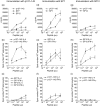Immunotherapeutic potential of the immunodominant T-cell epitope of lipocalin allergen Bos d 2 and its analogues
- PMID: 17944901
- PMCID: PMC2433335
- DOI: 10.1111/j.1365-2567.2007.02699.x
Immunotherapeutic potential of the immunodominant T-cell epitope of lipocalin allergen Bos d 2 and its analogues
Abstract
Lipocalin allergens, which contain most of the important animal-derived respiratory sensitizers, induce T helper type 2 (Th2) deviation, but the reasons for this are not clear. To explore the prospects for peptide-based allergen immunotherapy and to elucidate the characteristics of the immunodominant epitope of Bos d 2, BALB/c mice were immunized with a peptide containing the epitope, peptides containing its analogues, peptides from the corresponding regions of other lipocalin proteins, and peptides with a homologous sequence. We observed that murine spleen cells recognized the immunodominant epitope of Bos d 2, p127-142, in almost the same way as human Bos d 2-specific T cells did. Enzyme-linked immunosorbent spot-forming cell assay (ELISPOT) analyses showed that p127-142 and a corresponding peptide from horse Equ c 1 induced a Th2-deviated cellular response, whereas a homologous bacterial peptide from Spiroplasma citri induced a Th0-type response. Interestingly, the spleen cell response to the bacterial peptide and p127-142 was cross-reactive, that is, able to induce reciprocally the proliferation and cytokine production of primed spleen cells in vitro. More importantly, the peptides were able to skew the phenotype of T cells primed with the other peptide. Our results suggest that modified peptides can be useful in allergen immunotherapy.
Figures






Similar articles
-
Lipocalin allergen Bos d 2 is a weak immunogen.Int Immunol. 2002 Apr;14(4):401-9. doi: 10.1093/intimm/14.4.401. Int Immunol. 2002. PMID: 11934876
-
Potential of an altered peptide ligand of lipocalin allergen Bos d 2 for peptide immunotherapy.J Allergy Clin Immunol. 2007 Apr;119(4):965-72. doi: 10.1016/j.jaci.2007.01.011. Epub 2007 Mar 1. J Allergy Clin Immunol. 2007. PMID: 17335888
-
The immunodominant epitope of lipocalin allergen Bos d 2 is suboptimal for human T cells.Eur J Immunol. 2003 Jun;33(6):1717-26. doi: 10.1002/eji.200322952. Eur J Immunol. 2003. PMID: 12778490
-
The major horse allergen Equ c 1 contains one immunodominant region of T cell epitopes.Clin Exp Allergy. 2007 Jun;37(6):939-47. doi: 10.1111/j.1365-2222.2007.02722.x. Clin Exp Allergy. 2007. PMID: 17517108
-
Important animal allergens are lipocalin proteins: why are they allergenic?Int Arch Allergy Immunol. 1999 Dec;120(4):247-58. doi: 10.1159/000024277. Int Arch Allergy Immunol. 1999. PMID: 10640908 Review.
Cited by
-
An update on paediatric asthma.Eur Respir Rev. 2012 Sep 1;21(125):175-85. doi: 10.1183/09059180.00003212. Eur Respir Rev. 2012. PMID: 22941882 Free PMC article. Review. No abstract available.
References
-
- Åkerstrom B, Flower DR, Salier JP. Lipocalins. Unity in diversity. Biochim Biophys Acta. 2000;1482:1–8. - PubMed
-
- Virtanen T, Zeiler T, Mäntyjärvi R. Important animal allergens are lipocalin proteins: Why are they allergenic? Int Arch Allergy Immunol. 1999;120:247–58. - PubMed
-
- Zeiler T, Mäntyjärvi R, Rautiainen J, Rytkönen-Nissinen M, Vilja P, Taivainen A, Kauppinen J, Virtanen T. T cell epitopes of a lipocalin allergen colocalize with the conserved regions of the molecule. J Immunol. 1999;162:1415–22. - PubMed
-
- Saarelainen S, Zeiler T, Rautiainen J, Närvänen A, Rytkönen-Nissinen M, Mäntyjärvi R, Vilja P, Virtanen T. Lipocalin allergen Bos d 2 is a weak immunogen. Int Immunol. 2002;14:401–9. - PubMed
-
- Immonen A, Saarelainen S, Rautiainen J, Rytkönen-Nissinen M, Kinnunen T, Mäntyjärvi R, Virtanen T. Probing the mechanisms of low immunogenicity of a lipocalin allergen, Bos d 2, in a mouse model. Clin Exp Allergy. 2003;33:834–41. - PubMed
Publication types
MeSH terms
Substances
LinkOut - more resources
Full Text Sources
Molecular Biology Databases

